Selecting the most effective Cumming Orthodontics for Effective Braces and Aligners Solutions
Selecting the most effective Cumming Orthodontics for Effective Braces and Aligners Solutions
Blog Article
Comprehensive Overview to Orthodontics Procedures for Correcting Oral Imbalances
Comprehending the details of each procedure, including their mechanisms, benefits, and possible disadvantages, is critical in making informed choices about one's orthodontic treatment. As we browse via the thorough overview to orthodontic procedures for correcting oral misalignments, the detailed information of each method will unravel, dropping light on the course toward a unified and practical oral alignment.
Orthodontic Procedures Overview

Routine modifications and surveillance are important components of orthodontic treatment to ensure progression is on track and to make any type of necessary alterations along the way. By undertaking orthodontic treatments, clients can not just attain a straighter grin however also improve their total dental health and feature.
Typical Braces: Exactly How They Function
When taking into consideration orthodontic therapies for oral misalignments, typical dental braces attract attention as a tried and true technique for remedying teeth positioning. Standard braces contain braces, wires, and bands that collaborate to apply continual pressure on the teeth, gradually moving them into the desired positioning. The brackets are affixed to the teeth using an unique adhesive, and the wires are threaded via the braces. By adjusting the tension of the cables, orthodontists can regulate the instructions and force put on each tooth, guiding them into proper alignment over time.
As stress is used to the teeth through the braces, the bone surrounding the teeth is reshaped to sustain the new tooth positions. People will require regular changes at the orthodontist's office to guarantee the dental braces proceed to use the correct pressure for efficient teeth activity.
Unnoticeable Aligners: Cons and pros
Invisible aligners provide a convenient and very discreet choice to standard dental braces for correcting dental misalignments. These clear, custom-made trays are virtually unseen when worn, making them an enticing option for people seeking a much more aesthetically pleasing orthodontic therapy. Among the primary benefits of unseen aligners is their removability, enabling less complicated maintenance of dental health compared to standard dental braces. Patients can eliminate the aligners prior to consuming or cleaning their teeth, decreasing the risk of food obtaining stuck in the device and streamlining the cleansing procedure.

Surgical Orthodontic Options
Surgical interventions in orthodontics present viable options for resolving complex oral misalignments that might not be this hyperlink successfully solved via conventional orthodontic treatments. While standard dental braces and invisible aligners can fix several orthodontic concerns, particular situations need surgical intervention to attain optimal outcomes. Surgical orthodontic options are generally suggested for severe malocclusions, considerable jaw inconsistencies, and situations where the underlying bone structure needs adjustment to attain proper positioning.
One typical surgical orthodontic procedure is orthognathic surgical procedure, which includes repositioning the jaws to remedy useful problems such as problem eating or talking. This surgical treatment is typically performed in partnership with an orthodontist who aids straighten the teeth prior to and after the procedure. Surgical orthodontics might likewise entail treatments to reveal influenced teeth, eliminate excess periodontal tissue, or improve the jawbone to create a more unified facial profile.
Before considering medical orthodontic options, people undergo an extensive evaluation to identify the necessity and potential advantages of such interventions. cumming orthodontics. While surgical procedure might seem challenging, it can considerably enhance both the function and aesthetic appeals of the smile in cases where conventional orthodontic you can look here therapies drop short
Retainers and Post-Treatment Treatment

Failure to abide with post-treatment treatment instructions can result in regression, where the teeth progressively move back towards their original positions. Constant retainer wear, great oral hygiene, and normal dental exams are necessary for maintaining the results attained through orthodontic surgical treatment and ensuring the long-term stability of the fixed oral placement.
Conclusion
Finally, orthodontic procedures offer different options for dealing with dental imbalances. Traditional braces utilize steel braces and wires to shift teeth into appropriate placement. Unseen aligners provide an even more discreet choice but may not be ideal for all situations. Surgical orthodontic alternatives are readily available for much more serious misalignments. Retainers are frequently used post-treatment to maintain the brand-new positioning. In general, orthodontic treatments can successfully improve oral health and wellness and visual appearance.
As we browse with the detailed guide to orthodontic treatments for remedying oral misalignments, the detailed details of each approach will unfold, shedding light on the course towards a practical and harmonious dental alignment. - cumming braces
One of the most common orthodontic therapies is the use of dental braces, which are composed of steel brackets and wires that apply mild pressure to gradually move teeth into the desired placement.When considering orthodontic treatments for oral misalignments, conventional braces stand out as a reliable approach for fixing teeth positioning. Additionally, unseen aligners might not be suitable for complicated orthodontic issues that need more considerable teeth motion, as they are typically advised for light to moderate instances. Retainers are customized orthodontic tools made to hold teeth in their fixed placements after the conclusion of orthodontic treatment.
Report this page